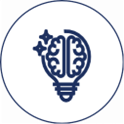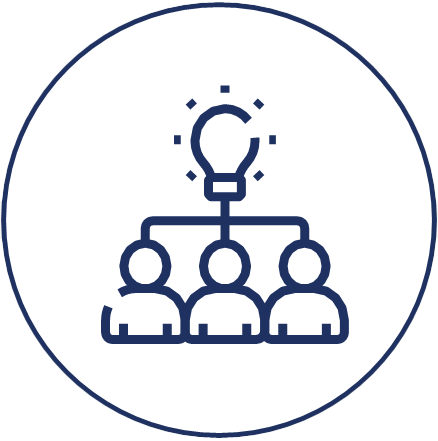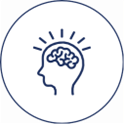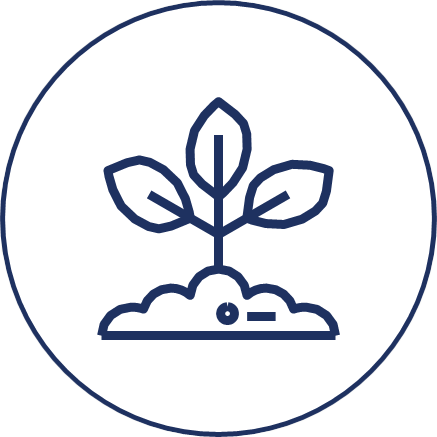
10 roles for impact at scale
The variety of potential roles needed to work towards impact at scale reflects the collaboration of actors with differing capabilities and focus.

- We have identified 10 overarching roles that are needed to work towards impact at scale.
- These roles complement each other and require collaboration and partnership between the different actors.
- Many of the roles will focus on changes to the overall system.
Continuing on from our last SVA Quarterly article on impact at scale, (10 design principles for impact at scale), here we look at the potential roles required in working towards an impact at scale goal or strategy.
The paper behind the article
The insights in this article are the result of SVA’s investigation into what it takes to create impact at scale – a major challenge for the Australian social sector.
To achieve this, SVA spoke with, surveyed and convened sector leaders from across the country and the public, private, philanthropic and non-government sectors.
The resulting paper explores four areas to support social purpose leaders and organisations to better understand and plan their efforts to drive lasting change across Australia: defining impact at scale, pathways to work towards impact at scale, key considerations for defining an impact at scale goal or strategy, and roles required to work towards an impact at scale goal or strategy.
The result of this work, supported by the AMP Foundation and the Paul Ramsay Foundation, is our paper on Impact at Scale which brings together a uniquely Australian set of perspectives on the topic.
Collaboration needed
Our conversations with social purpose leaders consistently highlighted that impact at scale is beyond the scope of any single organisation or individual. It requires genuine collaboration across a range of actors with differing capabilities and focus, working together towards a shared goal and aspiration. This diversity of expertise is important as it helps identify the different leverage points that shift an underlying social problem.
In reviewing Australian examples of impact at scale alongside our conversations with leaders, we identified distinct roles that are, and can be, adopted when undertaking this work. These roles provide the overarching priorities and mindsets that support different aspirations of impact at scale. Alongside the design principles and Routes to Scale pathways we’ve discussed, these roles provide guidance to social purpose leaders to help plan their efforts.
Collectively, the roles complement each other, compounding and accelerating efforts to drive impact at scale.
We have identified 10 overarching roles that are needed to work towards impact at scale.1 In most sectors, all or several of these roles will be required, and the roles needed may change over time as the context changes. In many cases various actors will be required to play the same role. This multiplicity often ensures that the breadth of levers is applied and a collective of actors with diverse mindsets and skills are collaborating to achieve the common goal.
Moreover, the boundaries between these roles can be blurred, as they are deeply interconnected and will be played by a myriad of actors, with some stepping in and out of roles as the context requires. Collectively, the roles complement each other, compounding and accelerating efforts to drive impact at scale. And collaboration and partnership between different actors playing different roles will often be a key enabler of change.
Many of these roles will focus on changes to the overarching system, reimagining what a new and better system could look like. Others may focus on changes and improvements within the system. This also means many of these roles will need to focus on the more implicit aspects of the system, including power dynamics, relationships and underlying mindsets.
By articulating these roles, our aim is to develop a shared vocabulary around the different efforts required to create impact at scale. We encourage readers to map their efforts and the efforts of others within their sector, and consider whether key roles are missing which may better support collective efforts to drive positive change.
These roles are not articulated with funders and government in mind, though each role will require the appropriate resourcing in order to undertake their efforts. Our aspiration in future pieces of work is to further explore the more specific roles of funders and government in impact at scale efforts.
The roles

Vision Setters have a deep understanding of an overarching social issue, and its challenges and opportunities, which they use to paint the picture of a better future. Vision Setters develop the overarching goal for impact at scale and seek buy-in from sector actors on the vision of a more positive future. They can be individuals who strive to build a better world, setting the direction regardless of whether the pathway is immediately clear. Vision Setters may often be undertaking another role to deploy the change required to shift the social issue.

Entrepreneurs seek to transform the system. They develop new system innovations, vehicles and frameworks to change the overarching structure. Entrepreneurs are disruptive, sometimes restructuring the system to better enable impact at scale by others. They are similar to Social Innovators in their strong innovative capabilities, however, their focus is on the broader system structures that hold a social issue in place.

Social Innovators design, develop and test new products, services or practices within a sector to create change. They have deep knowledge of underlying social issues and design improvements to existing supports and ways of working to create better outcomes. Social Innovators undertake social research and development, and co-design with beneficiaries to develop effective solutions. They will build an evidence base, pinpointing the contextual factors that influence the innovation’s effectiveness.

Scaled Providers either identify and scale ‘what works’ or leverage their existing market share to deploy products or services at scale. They pursue impact at scale by focussing on improving the quality, accessibility and equity of service provision at scale. Social Innovators may transition into Scaled Providers as they expand their innovations’ reach, often using a range of different vehicles or business models.

Knowledge Brokers are the researchers, experts and think tanks within a sector. They pursue impact at scale by developing, sharing and translating research and evidence to improve practices, mindsets or public policy. Knowledge Brokers will often play a key role across many pathways towards impact at scale. This includes building the evidence base for new services or ways of working, making the case for more supportive policies and translating key findings to shift community perspectives on social issues. Credibility and trust are often key characteristics of effective Knowledge Brokers.

Advocates serve as a strong voice on behalf of other sector actors. They support impact at scale by representing others’ needs and interests, typically to change practices, policies or systems. Advocates can take many forms. They may represent service delivery organisations, advocating for change within the sector to allow their members to create better social impact. Or they may represent those with lived experience, advocating for improved awareness of, and solutions to, social issues.

Campaigners harness the power of the collective to champion social change. By coordinating social movements and campaigns, Campaigners shift community mindsets and policies to enable impact at scale. They can leverage many different tools to inform and activate the public, including research and evidence, effective storytelling and the arts. Effective Campaigners keep lived experience at the centre, through narratives that hold the public’s attention, while making complex social issues accessible with clear explanations for why change is needed.

Coalition Builders act as the glue between other roles, convening and brokering partnerships. They facilitate and encourage meaningful collaboration towards impact at scale, often between similar or complementary roles. This requires a high level of trust and credibility, as Coalition Builders can bring together unlikely partners to more effectively work together. Coalition Builders often create new networks and unite communities towards achieving a shared goal of impact at scale.

Capacity Builders create opportunities for other sector actors to better deliver impact and develop their skills, capabilities and effectiveness. Capacity Builders often identify leaders within a sector, whether individuals or organisations, and focus on building their capabilities to amplify their impact. They may also develop the capabilities of local communities, supporting their self-determination and agency.

Catalysers are those who influence and amplify the efforts of others, often working behind the scenes. They are the sector optimisers, identifying and filling gaps within a sector by improving broader enablers and facilitating the work of others to drive improved outcomes. They focus on how to enable others to create better impact.
Case studies
Below are brief examples of Australian social purpose organisations working towards impact at scale and the various roles they’ve adopted to do so. More detailed case studies can be found in the supplementary document to this paper.
Berry Street and the Berry Street Educational Model (BSEM)
Social Innovator & Scaled Provider
BSEM is an evidence-led approach to teaching and learning that supports educators to improve outcomes for all students, particularly those with complex and unmet learning needs.
Berry Street drew on its 140-year history supporting vulnerable children alongside over 10 years of longitudinal research exploring trauma-informed, strengths-based teaching practices emerging from the Berry Street School with emphasis on increasing self-regulatory and relational capacities required for engagement with learning.
To date, BSEM has been able to expand its reach to over 70,000 Australian educators representing over 1,600 schools within government, faith-based and independent sectors. BSEM did this by remaining focused on quality delivery and implementation strategies throughout education systems to propel demand.
Evidence for Learning (E4L)
Knowledge Broker & Capacity Builder
E4L is an initiative within SVA that builds and shares evidence of the most reputable research to support Australian educators to improve teaching practices and deliver improved learning outcomes.
E4L’s independence from government, researchers and education program developers, alongside its focus on quality and tailored evidence to the Australian context, provides the credibility required to expand its reach. Further, E4L invests substantial resources in building the capabilities of schools, early learning settings and educators to effectively put the evidence and research into practice.
E4L has 26,000 frequent users of its materials across the nation, improving the quality, availability and use of evidence in education. Since its inception in 2015, there have been over 850,000 visits to, and over 150,000 downloads from, the E4L website.
Centre for Community Child Health (CCCH) and the Australian Early Development Census (AEDC)
Entrepreneur & Advocate
CCCH, in partnership with the Telethon Kids Institute, worked to develop, pilot and influence government adoption of the AEDC – a regular, national data collection on early childhood development enabling better policy and service planning.
CCCH drew on its research and design expertise to adapt the Canadian Early Developmental Index to the Australian context. It then leveraged its position as a trusted partner to government, alongside supporting influencers at the Australian Institute of Health and Welfare, the Australian Government and the Council of Australian Governments, to advocate for the nation-wide uptake of the AEDC. Since its national launch in 2009, it has collected critical developmental data from over 1.5 million children.
Health Justice Australia (HJA)
Capacity Builder, Catalyser, Advocate & Knowledge Broker
HJA is the national centre of excellence for health justice partnerships — a practitioner-led movement that is transforming the way health, legal and other services help people with complex, intersecting needs. HJA maintains a focus on the authorising environment through which health and justice services are funded and regulated, working to transform these systems to enable impact at scale.
It catalyses the impact of cross sector collaborations between practitioners by building the evidence base, undertaking advocacy and policy change, and enabling partnering and learning across services. HJA’s independence and its focus on evidence has enabled it to advocate and influence government funding, design and delivery at the federal and state level.
In 2023, there were over 110 health justice partnerships across Australia.
Authors: Divya Roy and Nick Perini
1 The roles also draw on the work of J Winhall and C Leadbeater, Building better systems: a green paper on system innovation, The Rockwool Foundation, 2020.






